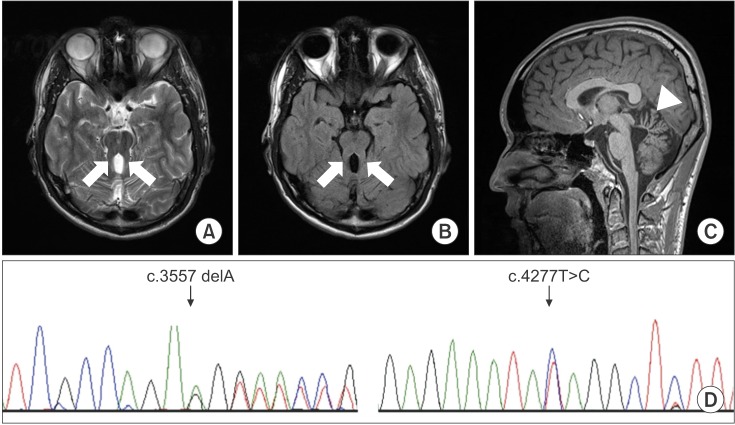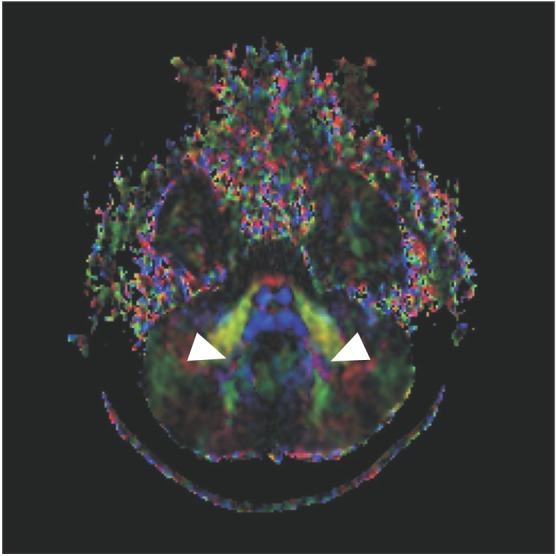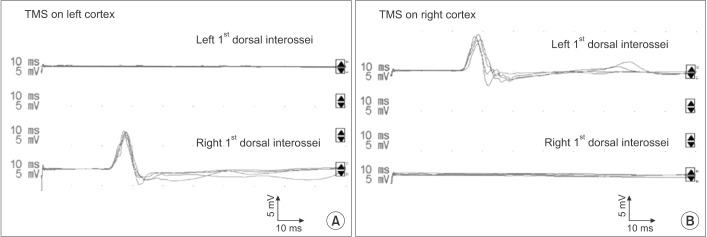Ann Rehabil Med.
2017 Aug;41(4):701-704. 10.5535/arm.2017.41.4.701.
Joubert Syndrome Presenting With Normal Pyramidal Decussation: A Case Report
- Affiliations
-
- 1Department of Physical Medicine and Rehabilitation, Chonbuk National University Medical School, Jeonju, Korea. shpark0130@jbnu.ac.kr
- KMID: 2389417
- DOI: http://doi.org/10.5535/arm.2017.41.4.701
Abstract
- Joubert syndrome (JS) is a rare genetic disorder characterized by a congenital malformation of the hindbrain, and accompanied by axonal decussation abnormalities affecting the corticospinal tract and the superior cerebellar peduncles. To the best of our knowledge, there are no reports of normal pyramidal decussation in JS. Here, we describe the case of an 18-year-old boy presenting midline-crossing corticospinal projections, which were considered normal corticospinal tract trajectories. Diffusion tensor imaging and motor evoked potential study analysis demonstrated the exclusive presence of decussating corticospinal projections in the patient. Based on these results, we suggest that JS might be associated with several, diverse corticospinal motor tract organization patterns.
MeSH Terms
Figure
Reference
-
1. Maria BL, Boltshauser E, Palmer SC, Tran TX. Clinical features and revised diagnostic criteria in Joubert syndrome. J Child Neurol. 1999; 14:583–590. PMID: 10488903.
Article2. Yachnis AT, Rorke LB. Neuropathology of Joubert syndrome. J Child Neurol. 1999; 14:655–659. PMID: 10511338.
Article3. Poretti A, Boltshauser E, Loenneker T, Valente EM, Brancati F, Il'yasov K, et al. Diffusion tensor imaging in Joubert syndrome. AJNR Am J Neuroradiol. 2007; 28:1929–1933. PMID: 17898198.
Article4. Theoret H, Gleeson J, Pascual-Leone A. Neurophysiologic characterization of motor and sensory projections in Joubert syndrome. Clin Neurophysiol. 2013; 124:2283–2284. PMID: 23906682.5. Srour M, Schwartzentruber J, Hamdan FF, Ospina LH, Patry L, Labuda D, et al. Mutations in C5ORF42 cause Joubert syndrome in the French Canadian population. Am J Hum Genet. 2012; 90:693–700. PMID: 22425360.
Article6. Schutta HS, Abu-Amero KK, Bosley TM. Exceptions to the Valsalva doctrine. Neurology. 2010; 74:329–335. PMID: 20101039.
Article7. Parisi MA, Pinter JD, Glass IA, Field K, Maria BL, Chance PF, et al. Cerebral and cerebellar motor activation abnormalities in a subject with Joubert syndrome: functional magnetic resonance imaging (MRI) study. J Child Neurol. 2004; 19:214–218. PMID: 15119482.
- Full Text Links
- Actions
-
Cited
- CITED
-
- Close
- Share
- Similar articles
-
- A Case of Neonatal Onset Joubert Syndrome
- Atlanto-Axial Dislocation with Odontoid Process Fracture Associated with "Cruciate Paralysis"
- A Case of Joubert Syndrome Associated with Nephrocalcinosis and Agenesis of Cerebellar Vermis
- Joubert Syndrome with Severe Hypotonia: A case report
- Joubert Syndrome Presented with Ocular Motor Apraxia





